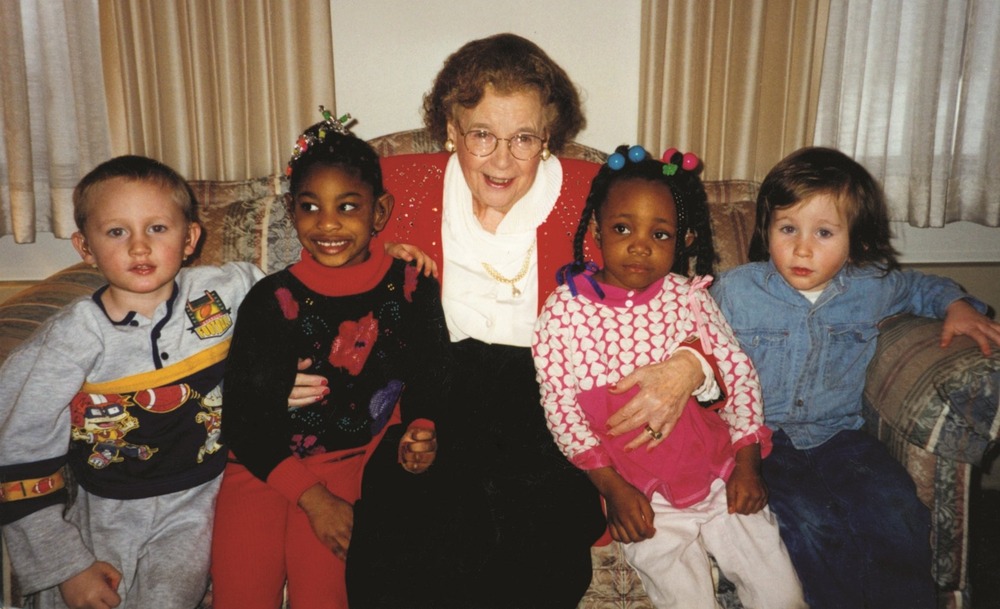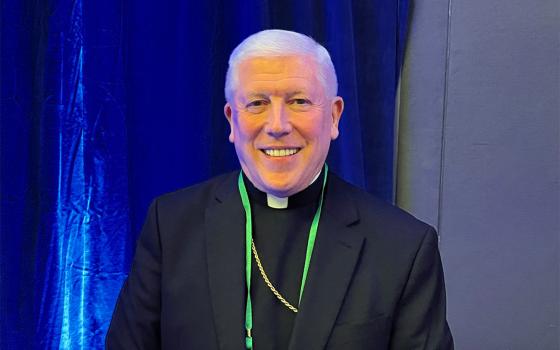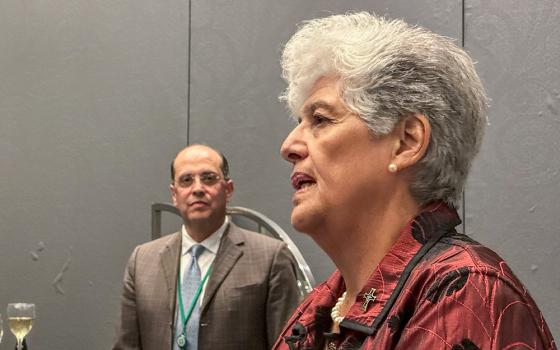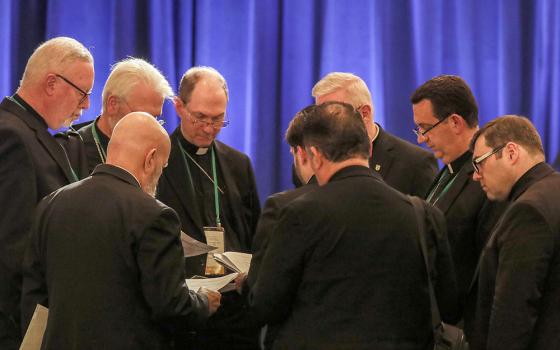
Gertrude Agnes Barber is pictured with children in an undated photo in Erie, Pa. Barber founded the Barber National Institute for adults and children with intellectual disabilities and behavioral health challenges. Her cause for canonization was presented during the Fall Assembly of the U.S. Conference of Catholic Bishops held Nov. 11-14, 2024. (OSV News/CNS file, courtesy Barber National Institute)
In 1918, when Benedictines in Minnesota gave Anna Cordelia Zervas her religious name, Sister Mary Annella, her mother reacted with surprise.
"But there is no St. Annella," she is reported to have said. Her daughter replied: "Then I shall have to be the first one!"
Annella's response may prove truer than she could have possibly known, as a cause for her canonization was presented to the U.S. Conference of Catholic Bishops Nov. 12. A separate cause for Gertrude Agnes Barber, a Pennsylvania educator committed to serving children and adults with learning disabilities, was also brought forward for the bishops' consultation.
During their fall plenary assembly in Baltimore, the U.S. bishops voted 206 to 7, with 11 abstentions, to support the local advancement of Annella's cause, and 205 to 6, with 19 abstentions, to support the same for Barber's cause.
Andrew H. Cozzens of Crookston, Minnesota, Annella's home diocese, introduced Annella's cause, while Bishop Edward M. Lohse of Kalamazoo, Michigan, introduced Barber's cause on behalf of Bishop Lawrence T. Persico of Erie, Pennsylvania.
The two women died 74 years apart — Annella in 1926 after suffering horribly from a rare skin condition, and Barber in 2000, after becoming a national leader and advocate in her field. Postulators for both causes are currently gathering information locally about the two women with plans to prepare a "positio" for the Dicastery for the Causes of Saints at the Vatican.
In the Diocese of Crookston, where Annella's cause for canonization is being investigated, sources are primarily historical, whereas for Barber's cause in the Diocese of Erie, Pennsylvania, people who knew her in life are contributing their memories.
Annella was born in 1900 in Moorhead, Minnesota, a growing town along the North Dakota border. She was a devout child, and, according to a biography, "demonstrated a spiritual maturity that set her apart from her peers." In 1915, a teenaged Zervas gained her pastor's approval and encouragement to enter the Benedictine convent in St. Joseph, Minnesota. She entered as a postulant that year, and four years later she professed her first vows. After her final vows in 1922, she was assigned to teach music and serve as an organist in Bismarck, North Dakota.
A short time later, itchy and swelling skin and hair loss — to the point where her visiting parents did not recognize her — led her to seek medical treatment at the Mayo Clinic in Rochester, Minnesota. The disease progressed, and her parents brought her home to Moorhead in the fall of 1924.

Sister Annella Zervas, a professed religious of the Order of St. Benedict, is pictured in this undated photo. Her cause for canonization was presented to the U.S. Conference of Catholic Bishops Nov. 12, 2024. (OSV News/courtesy of The Sister Annella Zervas, OSB, Guild)
"Despite her severe physical suffering, which included violent chills, high temperatures, and painful attacks of itching, scratching, and weeping, her mental faculties always remained intact," according to a biography. "The pus-like discharge from the skin disease had a sharp, biting, and decayed odor. Her frail body exfoliated between a pint and a quart a day of skin. At one point, she existed on almost no food."
Despite her suffering, Annella remained cheerful, and amid fits of pain, she prayed. "Yes, Lord, send me more pain, but give me strength to bear it," she reportedly said. She only asked for God's will to be done. She died on the vigil of the Assumption, Aug. 14, 1926. After a funeral Mass in Moorhead, her remains were buried 160 miles southeast at St. Benedict's Monastery in St. Joseph.
Shortly after her death, reports of cures attributed to Annella's intercession began to circulate, and local devotion to her persisted for decades. However, it took one man's mysterious encounter and dogged determination to revive contemporary interest in the holy woman.
Patrick Norton, a devout Catholic and paint contractor in central Minnesota, was working on a replica of the Lourdes' grotto in the cemetery of St. Joseph's Monastery on Oct. 7, 2010 — the feast of Our Lady of the Rosary — when he said a sister in full habit approached and began a conversation. After talking a short time, she said goodbye and "disappeared," he recalled. She never told him his name, but he was struck by her large blue eyes. He later recognized the sister as Annella, and he made it his mission to spread her story.
Annella's suffering "reminds me of the passion of our Lord," said Norton, 62, who was cared for as an orphaned infant by Mother Teresa and her Missionaries of Charity in then-Bombay, India, before being adopted as a teen into a Connecticut family. After trying to gain traction for Annella's cause for years, he believes "God opened every door" to make it possible to move forward at this time.
In October 2023, Cozzens announced to a group of Catholics devoted to the nun that he was beginning an inquiry into her life that could lead to a cause for Annella's canonization. The effort is led by canon lawyers Amanda Zurface, the cause's postulator, and Msgr. David Baumgartner, president of the newly formed Sister Annella Guild. The guild is charged with advancing Annella's cause.
More consultation is needed before Cozzens officially opens a cause, Zurface told OSV News. However, Annella's "life was a testament to heroic virtue, and it offers us a profound witness of how suffering can be transformed into an offering of love for Christ and his church," Msgr. Baumgartner said.
Speaking to the bishops Nov. 12, Cozzens called Annella an "apostle of suffering for our day."
"Many people have expressed that her witness to the value of suffering has helped them embrace their own suffering with faith in God's goodness," he said. "Sister Annella is a true teacher of our Catholic faith, witnessing that each person, regardless of their struggle, has great dignity and is created for intimacy with God. And she teaches us that God is our truest friend, and our vocations are good even when they take a different path than we might expect."
Advertisement
While those who knew Annella in life have since died, memories of Gertrude Barber are still fresh for those with whom she worked and cared. Born 11 years after Annella in Erie, Pennsylvania, Barber grew up in a large Catholic family, attended Penn State University and began a teaching career in the Erie School District in 1931. She eventually became a school psychologist, where her job included turning students away from the school because of their intellectual disabilities.
"She was deeply affected as she saw parents face the agony of either keeping their children at home without access to an education or sending them away to a distant institution where they would be segregated from the world," states a short biography circulated by leaders of her canonization cause. "Dr. Barber was determined to find another way."
Her deep faith and view of all as children of God led Barber to begin a decades-long crusade to educate children with special needs. In 1952, she opened a classroom in Erie for students with intellectual disabilities, which expanded to meet the needs of other students with special needs as well as adults. She founded the Dr. Gertrude A. Barber Center, which included services for people with intellectual disabilities at every life stage, and her work received significant educational, civic and religious recognition. In 1990, at age 78, she traveled to Washington to witness the signing of the Americans with Disabilities Act.
Barber's cause officially opened in 2019, and she is now titled a "servant of God." "So many people have been inspired by her, and that's what's motivated all of this — you look at the life of somebody like Gertrude, who followed Christ so closely in her mission," Msgr. Tom McSweeney, a priest of the Diocese of Erie and the cause's postulator, told OSV News.
As the executive vice president of what is now named the Barber National Institute, Maureen Barber-Carey carries on her aunt's legacy. She recalls Barber's work as driven by her deep faith. She noted that Barber once gave her one of her jackets, and pinned to the inside of the sleeve was a prayer.
"She truly believed she was a servant of God, and she was doing God's work on earth," Barber-Carey said. "It was to have persons with disabilities acknowledged — that they were children of God, just as a person without a disability is, and as a child of God, they deserve every right to have every opportunity to be the best they can possibly be."
Erie Mayor Joe Schember warmly recalls Barber's work with his daughter, Jodi, who is now 39. "She did seem holy to me," Schember, a Catholic, said of Barber. "She was a very open person, a very friendly person."
Speaking to his fellow bishops Nov. 12, Lohse said that Barber's "life and witness call us to remember and honor the presence of Christ, even in the most vulnerable of our brothers and sisters, and to see reflected in them the beauty of a loving Creator."
After the "positio" for each woman is sent to Rome, it is to be reviewed and sent to the pope for a decree of heroic virtues. If the pope grants that decree, the person is given the title "venerable."
In general, for a cause to proceed to beatification, a confirmed miracle must be attributed to the venerable's intercession. A second miracle must be confirmed before a person is canonized.
"Especially in this time, people are longing for God," said Norton, Annella's longtime promoter. "These saints can bring souls to God. Not just one, not just two, but thousands and millions."





